| Home |
| Rarities Committee |
| IL400 Club |
| Checklist |
| Monthly Summaries |
| Birding Reports |
| Rarity Alerts |
| Historical Records |
| Articles |
| Gallery |
| Video Clips |
| Contact Us |
Bulletin 12:01 Rare Birds in Israel
February 2022
In this bulletin about rare birds in Israel, we provide an up-to-date account of all records evaluated by the Israel Rarities and Distribution Committee since the previous bulletin in December 2019. Records covered in this bulletin are of recent rarities recorded primarily during 2019 to 2021, including eleven new taxa added to the Israeli list, ten species and one subspecies. Ten are recent additions: Chinese Pond Heron, White-backed Vulture, African Crake, Three-banded Plover, Wilson’s Phalarope, White-throated Bee-eater, Broad-billed Roller, Black-faced Bunting, Chestnut Bunting and Eastern Red-rumped Swallow. Several older records are covered in this bulletin as well; of special note is the acceptance of the first African Desert Warbler for Israel, recorded in 2013, that went unnoticed until recently.
It is fascinating to witness the shift in the manner of rarity finding in Israel: Only two records of the recent eleven national first species were found by experienced field birders, while seven were found by amateurs or beginners, and the remaining two were caught randomly during ringing sessions. This phenomenon represents the considerable growth of birdwatching as a popular hobby in Israel, where nowadays there are far more amateur birdwatchers than keen birders. Thankfully, even amateur birdwatchers photograph unusual birds they encounter...
For each accepted record, full details are provided, including number of individuals observed, age/sex if known, dates, location, observers (finder and identified if different), and record number in Israel. For observations that could not be accepted, basic details on the date and location are included. It is important to note that by not accepting a record, the committee doesn’t claim that the original identification was wrong, rather that the committee doesn’t find the record to be standing in the criteria for a safe or nearly safe acceptance or, that there is a just controversial among the committee and or within the birding community regarding the original identification. In addition, we provide information on species that will no longer be evaluated by the IRDC.
Section 1: Records accepted to category A
Red-necked Grebe (Podiceps grisegena)
Persian Shearwater (Puffinus persicus)
Swinhoe's Storm-petrel (Oceanodroma monorhis)
Wilson's Storm-Petrel (Oceanites oceanicus)
Tundra/Taiga Bean Goose (Anser serrirostris/fabalis)
Lesser White-fronted Goose (Anser erythropus)
European Shag (Phlacrocorax aristotelis)
Yellow-billed Stork (Mycteria ibis)
Northern Bald Ibis (Geronticus eremita)
Chinese Pond-Heron (Ardeola bacchus)
Lappet-faced Vulture (Torgos tracheliotos negevensis)
White-backed Vulture (Gyps africanus)
Rüppell's Vulture (Gyps rueppelli)
Tawny Eagle (Aquila rapax)
Bateleur (Terathopius ecaudatus)
African Crake (Crex gregaria)
Senegal Thick-knee (Burhinus senegalensis)
Three-banded Plover (Charadrius tricollaris)
American Golden-Plover (Pluvialis dominica)
Wilson's Phalarope (Phalaropus tricolor)
Lesser Yellowlegs (Tringa flavipes)
Pectoral Sandpiper (Calidris melanotos)
Pin-tailed Snipe (Gallinago stenura)
Greater Painted-Snipe (Rostratula benghalensis)
Oriental Turtle-Dove (Streptopelia orientalis)
White-throated Bee-eater (Merops albicollis)
Broad-billed Roller (Eurystomus glaucurus)
Black-crowned Sparrow-Lark (Eremopterix nigriceps)
Turkestan Shrike (Lanius phoenicuroides)
Eastern Red-rumped Swallow (Cecropis daurica daurica)
Hypocolius (Hypocolius ampelinus)
Black-throated Thrush (Turdus atrogularis)
African Desert Warbler (Curruca deserti)
Paddyfield Warbler (Acrocephalus agricola)
Booted Warbler (Iduna caligata)
Common Grasshopper-Warbler (Locustella naevia)
Dusky Warbler (Phylloscopus fuscatus)
Firecrest (Regulus ignicapillus)
Blyth's Pipit (Anthus godlewski)
Yellow-throated Sparrow (Gymornis xanthocollis)
Black-faced Bunting (Emberiza spodocephala)
Chestnut Bunting (Emberiza rutila)
Section 2: Records not accepted
Matsudaira’s Storm-Petrel (Hydrobates matsudairae)
Barolo Shearwater (Puffinus baroli)
Great Shearwater (Puffinus gravis)
Red-necked Grebe (Podiceps grisegena)
Pin-tailed Snipe (Gallinago stenura)
Sabine’s Gull (Xema sabini)
Oriental Turtle-Dove (Streptopelia orientalis)
Eastern Red-rumped Swallow (Cecropis daurica daurica)
White-eared Bulbul (Pycnonotus leucotis)
Blyth’s Pipit (Anthus godlewski)
Arabian Golden Sparrow (Passer euchlorus)
It is fascinating to witness the shift in the manner of rarity finding in Israel: Only two records of the recent eleven national first species were found by experienced field birders, while seven were found by amateurs or beginners, and the remaining two were caught randomly during ringing sessions. This phenomenon represents the considerable growth of birdwatching as a popular hobby in Israel, where nowadays there are far more amateur birdwatchers than keen birders. Thankfully, even amateur birdwatchers photograph unusual birds they encounter...
For each accepted record, full details are provided, including number of individuals observed, age/sex if known, dates, location, observers (finder and identified if different), and record number in Israel. For observations that could not be accepted, basic details on the date and location are included. It is important to note that by not accepting a record, the committee doesn’t claim that the original identification was wrong, rather that the committee doesn’t find the record to be standing in the criteria for a safe or nearly safe acceptance or, that there is a just controversial among the committee and or within the birding community regarding the original identification. In addition, we provide information on species that will no longer be evaluated by the IRDC.
Section 1: Records accepted to category A
Red-necked Grebe (Podiceps grisegena)
- One in summer plumage, Ma'agan Michael, 28-July-2021 to 29-July-2021 (L. Galili, S. Kabessa et al.). Photographed. Sixth record.
| Red-necked Grebe (Podiceps grisegena) | ||
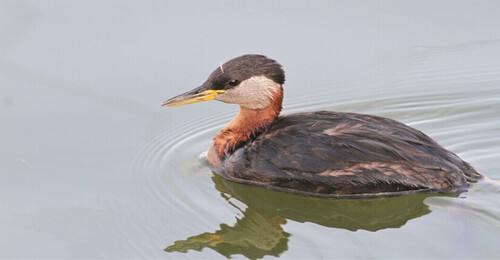 |
||
| July 2021 (© Jonathan Meyrav) | ||
Persian Shearwater (Puffinus persicus)
- One, Gulf of Aqaba off Eilat, 20-Oct-2020 to 25-Nov-2020 (S. Shalev, N. Weiss et al.). Photographed. Third record.
Swinhoe's Storm-petrel (Oceanodroma monorhis)
- One, Gulf of Aqaba, 13-Aug-2019 (G. Marinov et al.). Photographed. 11th record.
- One, Gulf of Aqaba, 6-Sep-2019 (N. Weiss et al.). Photographed. 12th record.
- One, Gulf of Aqaba, 13-Aug-2020 (Y. Perlman et al.). 13th record.
- One, Gulf of Aqaba, 11-Sep-2020 (N. Weiss et al.). Photographed. 14th record.
- One, Gulf of Aqaba, 18-Oct-2020 (N. Weiss et al.). Photographed. 15th record.
- Two, Gulf of Aqaba, 22-Aug-2021 (N. Weiss et al.). Photographed. 16th record.
- Two, Gulf of Aqaba, 17-Sep-2021 (N. Weiss et al.). Photographed. 17th record.
- One, Gulf of Aqaba, 27-Sep-2021 (J. Meyrav et al.). Photographed. 18th record.
- These records demonstrate that Swinhoe's Storm-Petrel is a regular visitor, especially in summer and early autumn, to the Gulf of Aqaba. In practice, Swinhoe's Storm-Petrel observations are effort-dependent, as singles or small numbers are seen during almost every pelagic trip out into the gulf in summer and autumn.
Wilson's Storm-Petrel (Oceanites oceanicus)
- One, Gulf of Aqaba, 8-Jul-2020 (G. Marinov et al.). Photographed. Fourth record.
- One, Gulf of Aqaba, 7-Sep-2020 (N. Weiss et al.). Fifth record.
Tundra/Taiga Bean Goose (Anser serrirostris/fabalis)
- One, Ram'On, 20-Nov-2020 (G. Leitner et al.). Photographed.
- One, Agamon Hula, 10-Mar-2021 to 16-Mar-2021 (Agamon Hula staff). Photographed.
- Both records may well refer to the same individual, heading south in late autumn, migrating back north to stopover at Agamon Hula in spring. This is the sixth ‘bean goose' record in Israel. Further work is still needed to clarify the identification of previous records.
Lesser White-fronted Goose (Anser erythropus)
- One, Mashe'n and Sderot reservoirs, 1-Dec-2019 to 17-Feb-2020 (S. Levi et al.). Photographed. Ninth record.
- One, Yakutza (Meitsar) Reservoir, 29-Dec-2020 to 25-Jan-2021 (D. Porat et al.). Photographed. 10th record.
- Additionally, the long-staying individual roaming between Eilat and Aqaba, first found in January 2018 (see Bulletin 11), remained in the region into January 2022.
European Shag (Phlacrocorax aristotelis)
- One 2cy, Ashkelon National Park and then Carmel Coast between Caesarea and Dor, 22-Mar-2021 to 17-Aug-2021 (H. Shirihai et al.). Photographed. Second record.
- First found at Ashkelon NP by H. Shirihai on 22-Mar-2021, where it remained till the next day. It was then relocated by I. Solnik near Caesarea, Carmel Coast on 27-Mar-2021. It stayed along Carmel Coast for a lengthy period, commuting between Dor Beach and Caesarea. Last seen 17-Aug-2021.
| European Shag (Phlacrocorax aristotelis) | ||
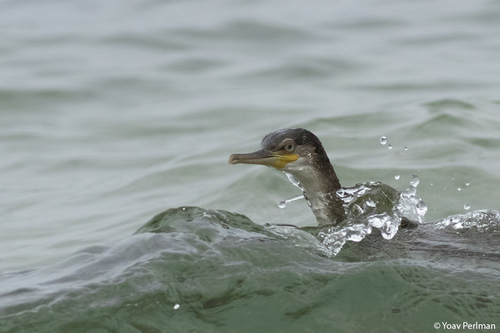 |
||
| March 2021 (© Yoav Perlman) | ||
Yellow-billed Stork (Mycteria ibis)
- One, Keshet, Golan Heights, 14-Jul-2020 (O. Saadia). Photographed. 29th record.
Northern Bald Ibis (Geronticus eremita)
- One 1cy, Gvulot, 11-Aug-2021 to 23-Aug-2021 (anonymous farmer et al.). Photographed.
- One 1cy, Bnei Netzarim, 27-Aug-2021 (H. Yaakov et al.). Photographed.
- Both individuals were colour-ringed, identifying them as originating from the semi-wild colony at Birecik in eastern Turkey. After years of being prevented from migrating, for the first time in July 13 individuals were free to migrate. There are 15 previous records of wild birds, most recent in 1995 (3 birds in Hazeva, H. Shirihai) and 2007 (2 birds in the Jordan Valley, C. Rohde). It would be interesting whether this autumn arrival repeats in following years.
| Northern Bald Ibis (Geronticus eremita) | ||
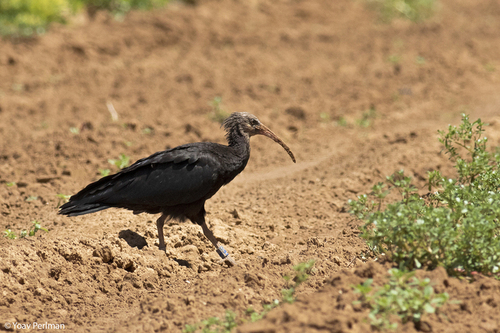 |
||
| August 2021 (© Yoav Perlman) | ||
Chinese Pond-Heron (Ardeola bacchus)
- One, Givat Ram Botanical Gardens, Jerusalem, 13-Apr-2021 to 16-May-2021 (D. Katz et al.). The first record for Israel.
| Chinese Pond-Heron (Ardeola bacchus) | ||
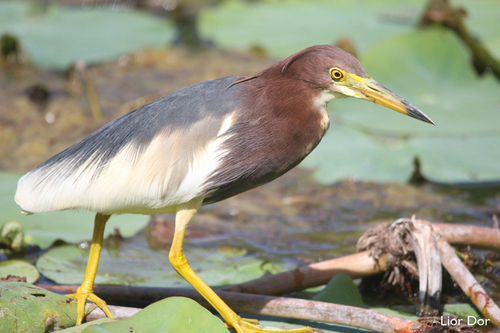 |
||
| April 2021 (© Leor Dor) | ||
Lappet-faced Vulture (Torgos tracheliotos negevensis)
- One, Hai Bar Yotvata NR, 27-Apr-2021 to 28-Apr-2021 and again 25-May-2021 (Hai Bar Yotvata NR staff). Fifth record after its extirpation of the breeding population in Israel in early 1990's.
| Lappet-faced Vulture (Torgos tracheliotos negevensis) | ||
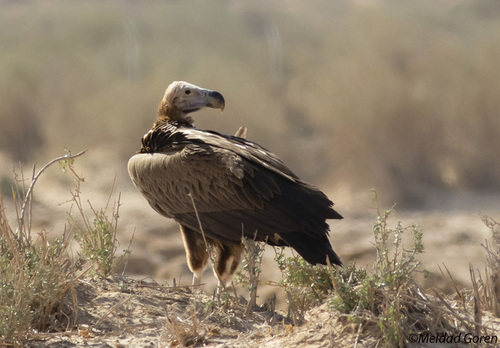 |
||
| April 2021 (© Meidad Goren) | ||
White-backed Vulture (Gyps africanus)
- One adult, Judean Desert, Bet Shean Valley and Galilee, 29-Apr-2021 to 3-May-2021 (A. Mizrachy, T. Kahn, Y. Vortman et al.). Photographed. First record for Israel. First photographed by Asaf Mizrachy over Nahal Og in the northern Judean Desert on April 29th. On May 1st it was picked up by T. Kahn near Maoz Haim in the Bet She'an Valley, over 70 km north. It was heavily twitched in the morning on May 2nd, then departed north. That afternoon it was picked up again by Y. Vortman near Elifelet in the eastern Galilee, another 50 km north. It was located going down to roost, and was seen again the next morning until it took off and disappeared north.
- One young bird, Judean Desert, 23-Jun-2021 to 24-Jun-2021 (captured by an online camera, identified by L. Lev). Photographed. Second record. This individual frequented a vulture feeding station in a remote section of the Judean Desert. It was not seen by a human eye.
| White-backed Vulture (Gyps africanus) | ||
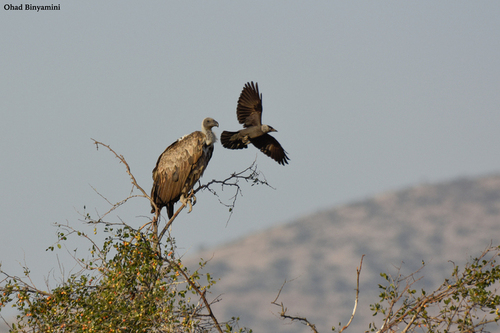 |
||
| May 2021 (© Ohad Binyamini) | ||
Rüppell's Vulture (Gyps rueppelli)
- One young bird, Tel Aviv, 18-May-2021 to 19-May-2021 (Identified from photos by E. Hadad, B, Granit and A. Ben Dov). Photographed. Second record. This exhausted vulture landed on the 43rd floor of a high-rise in Tel Aviv under construction. It was picked up by rangers of Israel Nature and Parks Authority, taken into care at a wildlife hospital where it died.
Tawny Eagle (Aquila rapax)
- One, Bet El, Samaria, 10-Jun-2021 to 23-Jul-2021 (D. Hilkiya (finder), B. Granit (identifier from photos)). Photographed. Seventh record, first of the lovely creamy plumage. It is still unclear what is the geographic origin of this and other records in Israel - either rapax/belisarius from Africa or vindhiana from Asia. The separation of the two groups is undescribed.
| Tawny Eagle (Aquila rapax) | ||
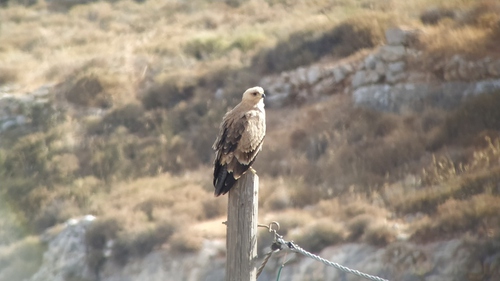 |
||
| July 2021 (© Yoav Perlman) | ||
Bateleur (Terathopius ecaudatus)
- One, young bird, Golan Heights, 4-Aug-2020 to 31-Aug-2020 (Y. Shelef et al.). Then refound near Gal'on, southern Judean Plains, 18-Nov-2020 to 6-Jan-2021 (S. Alon et al.). Photographed. 14th record.
- Close examination of high-quality photos of a Bateleur from Golan Heights and from Judean Plains proved this was the same individual, based on unique individual feather wear.
African Crake (Crex gregaria)
- One, Eilat, 2-Jan-2020 to 18-Jan-2020 (G. Partosh et al., identified by N. Weiss). Photographed. First record.
- The first African Crake was picked up exhausted on a busy street in Eilat by a member of the public. It was collected by Noam Weiss of IBRCE, taken into care at Hai Bar Yotvata NR, and released at IBRCE after recovery.
Senegal Thick-knee (Burhinus senegalensis)
- Two, Kfar Ruppin, 18-Jul-2020 to 5-Aug-2020 (T. Kahn et al.). Photographed. Second record.
| Senegal Thick-knee (Burhinus senegalensis) | ||
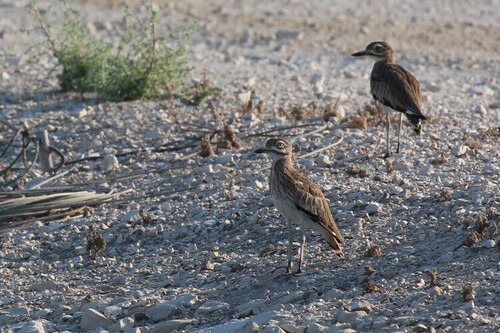 |
||
| August 2020 (© Nitay Haiun) | ||
Three-banded Plover (Charadrius tricollaris)
- One, Ma'ayan Tzvi, Hama'apil and Hula Valley, ringed, 12-Apr-2020 to 17-Mar-2021 (S. Alterman et al.). Photographed. First record in Israel. Found in Ma'ayan Zvi fishponds on 12-Apr-2020, where it remained until 23-May-2020. On6-Jun-2020 it was refound in Hama'apil fishponds by A. Sasson, where it remained until 16-Aug-2020. Ringed there on 10-Jun-20. On 26-Oct-2020 seen again at Ma'ayan Zvi by K. Rudnev. On 10-Feb-2021 it was refound at Bar'am fishponds, Hula Valley, by R. Shmueli, where it remained until 17-Mar-2021.
- One, Nov sewage pools and nearby Hital Reservoir, 30-Nov-2021 to at least 1-Jan-2022 (N. Nussbaum et al.). Photographed. Second record. This was an unringed bird thus confirmed as a different individual.
| Three-banded Plover (Charadrius tricollaris) | ||
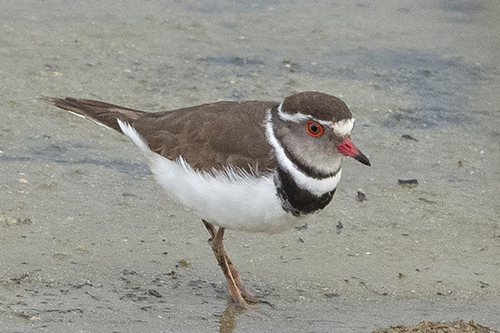 |
||
| April 2020 (© Yoav Perlman) | ||
American Golden-Plover (Pluvialis dominica)
- One, 1cy, Eilat Bird Park southern saltpans, 11-Dec-2020 to 23-Dec-2020 (S. Shalev et al.). Photographed. Second record.
- Due to the high possibility that the record from January 2009 at Acre is most likely related to the same individual found at Ma'agan Michael in November 2008 and overwintered (see Bulletin 8), IRDC decided to refer both observations as one record, thus Eilat record becomes second.
| American Golden-Plover (Pluvialis dominica) | ||
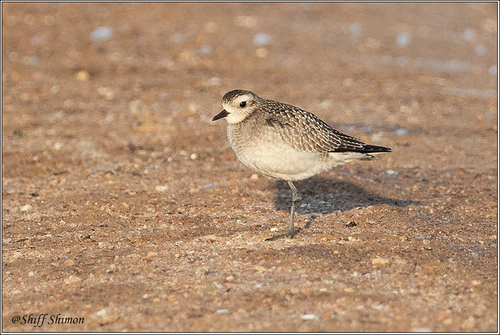 |
||
| October 2020 (© Shimon Shiff) | ||
Wilson's Phalarope (Phalaropus tricolor)
- One, Bet She'an Valley and Harod Valley, 18-Dec-2020 to 12-Mar-2021 (C. Rozen et al.). Photographed. First record for Israel.
- This bird overwintered in the Bet-Shean Valley and adjacent Harod Valley. It hopped between different reservoirs, first found in Maoz Hayim Reservoir, then moving to Kfar Ruppin, Bet Alfa and Neve Ur.
| Wilson's Phalarope (Phalaropus tricolor) | ||
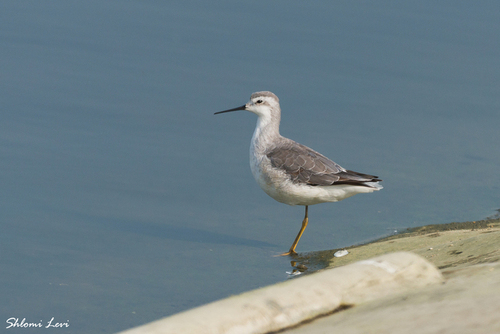 |
||
| January 2021 (© Shlomi Levi) | ||
Lesser Yellowlegs (Tringa flavipes)
- One, Ein Hamifratz and Kfar Hamaccabi, 19-Dec-2020 to 19-Mar-2021 (D. Melamed et al.). Photographed. Third record.
- This bird was found on 19-Dec-2020 but was barely seen the next day. Most probably the same individual was relocated 20 km south on 13-Feb-2021 by Y. Baser.
| Lesser Yellowlegs (Tringa flavipes) | ||
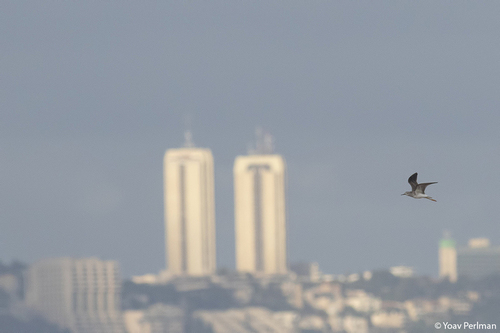 |
||
| February 2021 (© Yoav Perlman) | ||
Pectoral Sandpiper (Calidris melanotos)
- One, Gan Shmuel fishponds, 12-Sep-2020 to 18-Sep-2020 (S. Blitzblau et al.). Photographed. 15th record. Most probably the same individual at HaMa'apil fishponds, 8 km southwest, 6-Oct-2020 to 9-Oct-2020 (J. Meyrav et al.). Photographed.
Pin-tailed Snipe (Gallinago stenura)
- One, Tel Afek NP, 9-Oct-2021 to 12-Oct-2021 (O. Preplitzki, U. Stoffman (finders), B. Granit (identifier from photos). Photographed. 13th record.
- With the aid of high-quality photography, this individual was confirmed as Pin-tailed Snipe. Out of the twelve previous records, three were ringed and confirmed as Pin-tailed Snipe. Others are assumed to be so too, though Swinhoe's Snipe (Galinago megala) cannot be excluded with certainty, based on current knowledge.
| Pin-tailed Snipe (Gallinago stenura) | ||
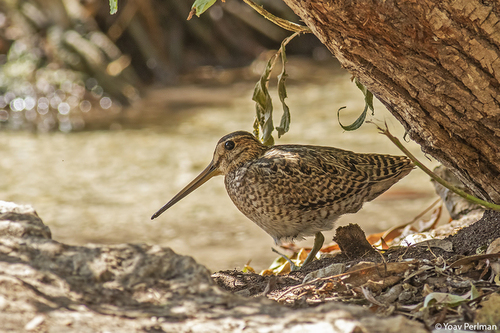 |
||
| October 2021 (© Yoav Perlman) | ||
Greater Painted-Snipe (Rostratula benghalensis)
- One, female, Poleg Marsh, 4-May-2020 (Y. Lenard and L. Flam). Photographed.
- One, male, ringed, HaMa'apil fishponds, 29-Sep-2020 to at least Jan-2022 (S. Blitzblau et al.). Photographed.
Oriental Turtle-Dove (Streptopelia orientalis)
- One, Yotvata, 7-Nov-2019 (J. Niemi). Photographed. 17th record.
- One, Tirat Yehuda, 8-Nov-2019 (Y. Szabo). Photographed. 18th record.
- One, Kfar Etzion, 19-Jan-2020 to 18-Feb-2020 (Y. Bashan et al.). Photographed. 19th record.
- One, Jerusalem Bird Observatory, 23-Oct-2020 (R. Feibis et al.). Photographed. 20th record.
- One, Tsor'a, 26-Oct-2020 to 1-Nov-2020 (M. Mandel et al.). Photographed. 21st record.
- one, Ha'tzuk beach, Tel Aviv, 8-Nov-2021 (Y. Siman tov). Photographed. 22nd record.
- All records here refer to ssp. meena.
White-throated Bee-eater (Merops albicollis)
- One, KM20 date plantations, Eilat, 13-Aug-2019 to 5-Oct-2019 (S. Shiff, S. Deutch et al.). Photographed. First record. Heavily twitched during its prolonged stay.
| White-throated Bee-eater (Merops albicollis) | ||
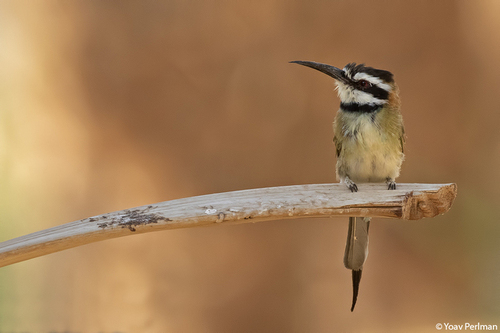 |
||
| August 2019 (© Yoav Perlman) | ||
Broad-billed Roller (Eurystomus glaucurus)
- One, Kibbutz Karmiya, 12-Sep-2019 to 18-Sep-2019 (G. Levitzky et al.). Photographed. First record. Well twitched during its week-long stay.
| Broad-billed Roller (Eurystomus glaucurus) | ||
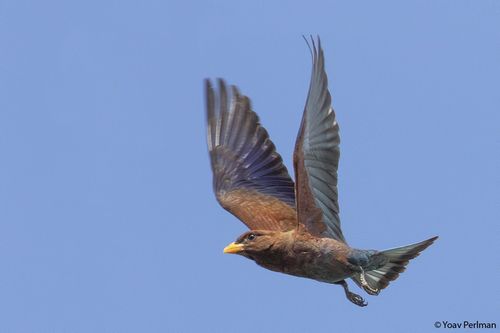 |
||
| September 2019 (© Yoav Perlman) | ||
Black-crowned Sparrow-Lark (Eremopterix nigriceps)
- One, male, KM94, Arava Valley, 17-Apr-2020 (P. Ish Shalom and R. Livne). Photographed.
| Black-crowned Sparrow-Lark (Eremopterix nigriceps) | ||
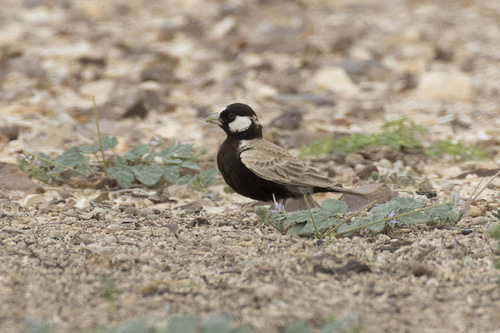 |
||
| April 2020 (© Rony Livne) | ||
Turkestan Shrike (Lanius phoenicuroides)
- One male, Nahal Ezuz, 29-Mar-2021 (O. Ovadia). Photographed.
- One male, Shezaf Nature Reserve, 5-May-2021 (A. Alaman). Photographed.
Eastern Red-rumped Swallow (Cecropis daurica daurica)
- One, Ma'agan Michael, 21-Dec-2019 to 10-Jan-2020 (K. Rudnev et al.). Photographed. First record.
- One, Eilat Bird Park, 14-Dec-2020 to 25-Dec-2020 (N. Weiss et al.). Photographed. Second record.
- One, Atlit, 26-Dec-2020 (Y. Gordon). Photographed. Third record.
- A remarkable trio of first records of the eastern taxon of Red-rumped Swallow.
Hypocolius (Hypocolius ampelinus)
- One female, KM20 date plantations, Eilat, 14-Aug-2019 to 24-Aug-2019 (T. Kahn et al.). Photographed. 18th record.
- One female, Revivim, 13-Oct-2020 to 18-Oct-2020 (M. Laloya). Photographed. 19th record.
- One female, Atlit, 26-Dec-2021 to 8-Feb-2021 (O. Efroni-Naor et al.). Photographed. 20th record.
- The Eilat record was a by-product of the White-throated Bee-eater discovery, found by a birder searching for the bee-eater.
Black-throated Thrush (Turdus atrogularis)
- One-female, Mt. Herzl, 11-Dec-2019 (B. Granit). Photographed. 14th record.
- One, male, Begin Park, 14-Jan-2020 to 14-Feb-2020 (T. Magen et al.). Photographed. 15th record.
- One, male, Mt. Herzl, Jerusalem, 24-Dec-2021 to at least 8-Jan-2022 (Y. Salaviz et al.). Photographed. 16th record.
| Black-throated Thrush (Turdus atrogularis) | ||
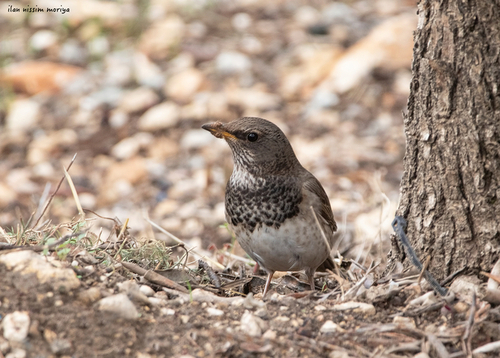 |
||
| December 2021 (© Ilan Nissim Moriya) | ||
African Desert Warbler (Curruca deserti)
- One, Shikmona, Haifa, 20-Apr-2013 (A. Goldstein). Photographed. First record.
- This record occurred before African and Asian Desert Warblers were split, therefore it gained less attention in real-time. The record went lost for several years, until identified from photos retrospectively. The individual photographed beautifully showed all classic features confirming this was in fact African Desert Warbler, and not Asian Desert Warbler which is a regular winter visitor in the desert regions of Israel.
| African Desert Warbler (Curruca deserti) | ||
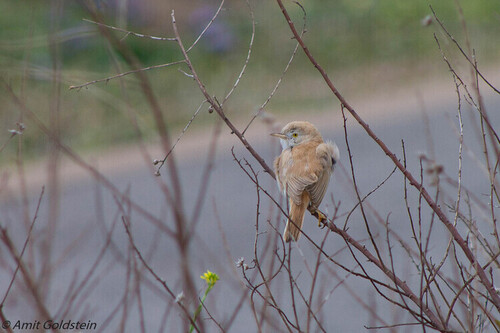 |
||
| April 2013 (© Amit Goldstein) | ||
Paddyfield Warbler (Acrocephalus agricola)
- One, Neve Ur fishponds, 19-Oct-2019 to 22-Oct-2019 (G. Moshe et al.). Photographed. 13th record. This bird was found and identified in the field and later was ringed.
- One, ringed, Agamon Hula, 12-Sep-2020 (Y. Lenard et al.). Photographed. 14th record.
- One, ringed, Agamon Hula, 7-May-2021 (Y. Ben-Aroya et al.). Photographed. 15th record.
- One, ringed, IBRCE Eilat, 4-Sep-2021 (S. Shalev et al). Photographed. 16th record.
Booted Warbler (Iduna caligata)
- One, ringed, IBRCE Eilat, 16-Oct-2019 (N. Weiss et al.). Photographed. Third record.
Common Grasshopper-Warbler (Locustella naevia)
- One, ringed, Poleg Marsh, 22-Aug-2020 (Y. Lenard et al.). Photographed. 16th record.
Dusky Warbler (Phylloscopus fuscatus)
- One, ringed, Poleg Marsh, 22-Oct-2020 to 23-Oct-2020 (Y. Lenard et al.). Photographed. Ninth record.
- One, ringed, Yeruham Lake, 27-Oct-2020 (R. Livne et al.). Photographed. 10th record.
- One, ringed, Rosh Tzipor, Tel Aviv, 28-Oct-2020 to 14-Nov-2020 (I. Berger et al.). Photographed. 11th record.
- One, Hatzuk Beach, Tel Aviv, 13-Nov-2020 (E. Stone). Photographed. 12th record.
- One, ringed, Rosh Tzipor, Tel Aviv, 21-Apr-2021 (E. Hoter et al.). 13th record, second spring record.
- Undoubtedly, autumn 2020 saw a peak of records for this species, with four records within three weeks.
| Dusky Warbler (Phylloscopus fuscatus) | ||
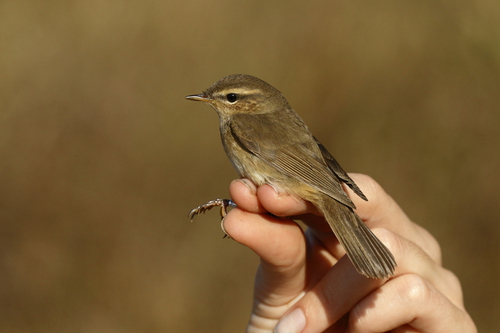 |
||
| October 2020 (© Yotam Lehnardt) | ||
Firecrest (Regulus ignicapillus)
- One, Birya Forest, 8-Dec-2021 to at least 8-Jan-2022 (Y. & E. Kaufman et al.). Photographed. Second record.
| Firecrest (Regulus ignicapillus) | ||
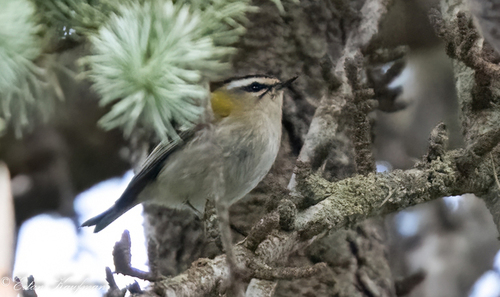 |
||
| December 2021 (© Judith Kaufman) | ||
Blyth's Pipit (Anthus godlewski)
- One, Arsuf, 11-Mar-2020 to 19-Mar-2020 (E. Shochat et al.). Photographed. Seventh record.
- One, Hatzuk Beach, Tel Aviv, 28-Apr-2020 (Y. Chen, identified from photos by B. Granit). Photographed. Eighth record.
Yellow-throated Sparrow (Gymornis xanthocollis)
- One, Mt. Keta, Golan Heights, 21-May-2019 (N. Sapir). Seventh record.
- One, ringed, Einot Tzukim NR, 25-Aug-2020 (R. Haran). Photographed. Eighth record.
Black-faced Bunting (Emberiza spodocephala)
- One, 1cy, ringed, Agamon Heffer, 31-Oct-2021 to 1-Nov-2021 (F. Argyle, Y. Kiat (identifier from photos) et al.). Photographed. The first record for Israel.
| Black-faced Bunting (Emberiza spodocephala) | ||
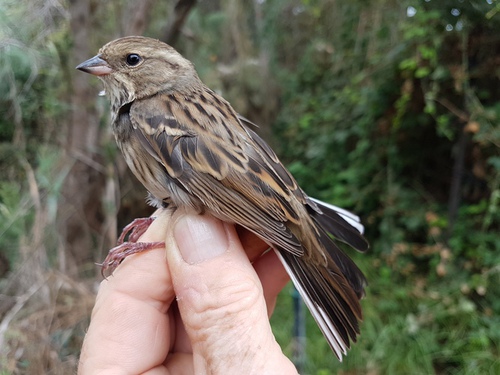 |
||
| December 2021 (© Francis Argyle) | ||
Chestnut Bunting (Emberiza rutila)
- One, 1cy, ringed, IBRCE Eilat, 3-Nov-2021 (I. Gorin, N. Weiss et al.). Photographed. The first record for Israel, only four days after the first Black-faced Bunting.
| Chestnut Bunting (Emberiza rutila) | ||
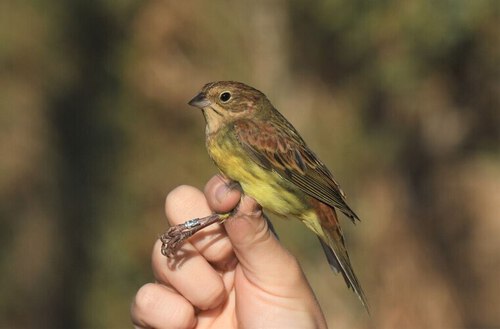 |
||
| November 2021 (© Noam Weiss) | ||
Section 2: Records not accepted
Matsudaira’s Storm-Petrel (Hydrobates matsudairae)
- One, Gulf of Aqaba, 22-Aug-2021 (N. Weiss et al.).
- The committee was not convinced that the photographs and the description published online, were conclusive for Mastudaira’s Storm-Petrel and not the very similar Swinhoe’s Storm-Petrel. The committee acknowledges the extensive field experience the main observer has with Swinhoe’s Storm-Petrel. However, the lack of direct comparative views of the bird in question with Swinhoe’s Storm-Petrel makes size and structure comparison more subjective. Additionally, the photographs show a shallow tail-fork - a contradicting ID feature while the tail was not especially long as expected in Mastudaira’s. The difference in flight behaviour described is apparently not conclusive, based on general field experience and knowledge with Swinhoe’s Storm-Petrel. Supporting features such as large bill and larger wing panel may have been an artifact of unsharp photos (makes things appear larger than they are) and heavy moult, and their reliability is anyway questionable. It is worth noting that Swinhoe’s Storm-Petrels with similar wing pattern and moult pattern have been previously photographed at Eilat at a similar time of year. For such a massive record, potentially a first for the Western Palearctic which includes a real ID challenge, more conclusive evidence is necessary, including higher quality of photos and a bird with a perfect set of features.
Barolo Shearwater (Puffinus baroli)
- One, Shikmona, Haifa, 30-Jan-2021 (N. Sapir and Y. Koren).
- Despite the observers’ report of good observation conditions, the description lacked important identification features (dark eye contrasting with pale face), while described features are not conclusive for that species or hard to be judged objectively with no other bird to directly compare with. Taking into account the extreme rarity in the Mediterranean and still being an ultra-rare vagrant in Israel with a sole record only, this record could not be accepted.
Great Shearwater (Puffinus gravis)
- One, Shikmona, Haifa, 1-Mar-2020 (Y. Koren)
- The bird was seen from relatively close distance but only some features were noted while several other important features weren’t seen. The description is lacking the crucial criteria for safe acceptance when dealing with a single-observer record of a mega rarity at sea.
Red-necked Grebe (Podiceps grisegena)
- One, Ayalon WTP, 25-Dec-2020 to 30-Dec-2020 (D. Alon et al.).
- Despite being reported by several experienced birders, all sightings obtained during its stay were tantalizingly brief, and lacked details including separation from an aberrant Black-necked Grebe (Podiceps nigricollis) that was present there at the same time. Many birders spent many hours searching the reservoir and returned empty-handed. The possibility of an error in identification could not be excluded with confidence and the record couldn’t be safely accepted.
- One, young bird, Agamon Hula, 21-May-2020 (R. Shaish).
- This bird was seen only briefly, and was not photographed. Better documentation is necessary for acceptance.
Pin-tailed Snipe (Gallinago stenura)
- One, Tal Shahar, 20-Sep-2020 (Y. Perlman and P. Ish Shalom).
- This bird was seen briefly and only in-flight as it got further away from the observers until it disappeared, enabling far from ideal observation. As it is still a very rare bird in Israel, better conditions and documentation are necessary for acceptance.
Sabine’s Gull (Xema sabini)
- One, first-winter, off Jaffa, 1-Mar-2020 (J. Meyrav).
- No supporting information was published on this record. Therefore, the record couldn’t be accepted.
Oriental Turtle-Dove (Streptopelia orientalis)
- One, 1cy, IBRCE Eilat, 23-Oct-2021 (J. Knocha).
- The photographs published online didn’t show important identification features. While this species is a regular autumn vagrant, its identification is not straightforward always, and better documentation is required for acceptance.
Eastern Red-rumped Swallow (Cecropis daurica daurica)
- One, Nekarot Reservoir, Arava, 9-Jan-2020 (A. Rinot et al.)
- This observation occurred amidst a small influx of Eastern Red-rumped Swallows in Israel (see Section 1 above). While it is possible that this was too an Eastern Red-rumped Swallow, the documentation (including photos) provided by the observers lacked the important identification features of this eastern vagrant, including underparts streaking and connected nape and mantle.
White-eared Bulbul (Pycnonotus leucotis)
- One, Eilat north beach and IBRCE, 26-Jul-2021 and 17-Oct-2021 (S. Hizkiya et al.).
- While there is no doubt about the identification of this bird, there is doubt about its origin. White-eared Bulbul is expanding its range naturally in Arabia (Jem Babbington pers. comm.). However, the nearest naturalised population at El-Azraq in Jordan is of feral origin. Additionally, this species is held in captivity in Jordan in large numbers (see p. 14 in this recent report on illegal bird trade in Jordan), also reportedly in other Middle Eastern countries. Therefore, there is serious doubt that this bird is of wild origin.
Blyth’s Pipit (Anthus godlewski)
- One, Hatzuk Beach, Tel Aviv, 22-Oct-2020 to 24-Oct-2020 (J. Meyrav et al.).
- Despite being reportedly seen by several birders during its three-day stay, no documentation was obtained - photographs or sound recordings. Blyth’s pipit is still extremely rare in Israel, and documentation is required for acceptance.
Arabian Golden Sparrow (Passer euchlorus)
- One, Nahal Nemiya, Arava Valley, 20-Nov-2021 (Y. Koren).
- This record is not accepted due to non-optimal conditions in which the bird was seen, and lack of any documentation. The details provided by the observer were not sufficient to confirm that this was an Arabian Golden Sparrow without doubt, or even exclude Sudan Golden Sparrow (Passer luteus) or other yellowish finches.
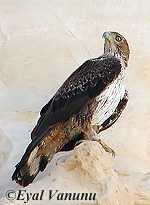 Bonelli's Eagle (Hieraaetus fastiacus) Sde Boqer, Apr.04 |
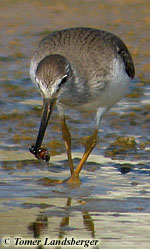 Terek Sandpiper (Xenus cinereus) Ma'agan Michael, Jul.05 |
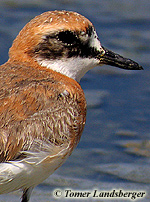 Greater Sand Plover (Charadrius leschenaultii) Eilat, Mar.05 |
Back to top